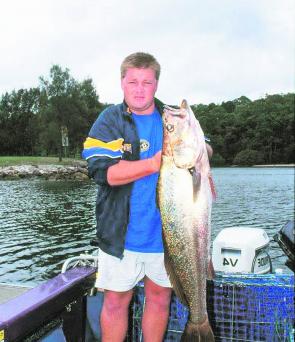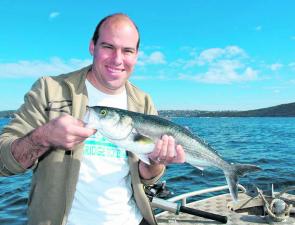Those hideous freaks of the deep, John dory, have moved into the harbour from their offshore haunts to do a bit of breeding. The mulloway have moved upstream and there’s enough salmon to keep an angler occupied.
They come in about mid May and can be caught right through until about the end of September. While spending a bit of time thinking about the characteristics of dory, I suddenly realised how similar they were to mulloway.
Neither fish are caught in big numbers, usually 1 at a time, 2 if you are lucky and 3 in a blue moon. Both species are energy conservers, spending a lot of time around and in caves and wrecks doing very little. Some people personify this as ‘lazy’, but it is simply a subconscious survival trait, one that obviously works! Unfortunately from an angler’s perspective, this trait is reflected in their fighting characteristics. They are both very specific about what they eat and hence your bait choice. In my opinion, you are loitering around the outer edge of the ballpark unless you are using fresh squid for mulloway and live reef fish for dory. Both species feed for a short period around the turn of the tides, particularly the high but the low is worth a shot if that is all you have to work with.
Short trips are the order of the day, 4 hours max, with half that time allocated to bait gathering. The anglers you hear of doing all-nighters for mulloway either don’t understand the fish or have unlimited time.
The best time to catch either of these fish is from the last half hour of the run up until 1 hour past high; 20 minutes past high tide is the sweet spot. The common theory for this is that the lack of water flow suits their ‘lazy’ temperament. My theory is that the prey species are forced to relocate once the tide changes and are at their most vulnerable when they are on the move. Their holding positions are eddy based and the eddy changes when the tide changes. Hence, the prey species are forced to move out of their comfort zone and into the next one.
This is a good time of year to catch a few mulloway in the upper reaches of the harbour’s tributaries if you are prepared to brave the cold. Despite the water being very cold, the fish are still relatively active and even prepared to chase a lure.
While I still maintain that fresh squid is number one mulloway bait overall, for the short time that they are in the upper reaches, they are focused on mullet and hence lures become a fair option.
Bridges at night are top spots. Mulloway are an open water ambush predator, this means that they use dirty or dark water to hide in. This differs from structure-oriented predators, like flatties, that bury in the sand or bass that hide in a snag or weed bed. Lights on a road bridge throw light onto the water next to the bridge and cast a shadow of the bridge under it. This sets up three ideal situations for mulloway to feed. The light water attracts bait like mullet, the shadow gives the predators a place to hide and mount their attack and the pylons create a pressure wave for them to rest in while they are not attacking.
The scenario is like this: bait swarms in the light water, mulloway hide in the dark water and every now and then, burst into the light water to grab a feed. Mulloway and the bait will always face into the current and the bait at night is generally on the surface.
From all this, we can see that the best way to catch mulloway around a bridge at night is with surface lures/poppers, on the side of the bridge that the current is flowing onto and right along the line where the bridge casts a shadow on the water. This can be very exciting fishing!
There is a few salmon starting to show up early, so hopefully they should be in good numbers by now.
Unfortunately, we all know that big schools of salmon in the early season does not necessarily mean lots of fish on your line. They are very fussily feeding on newly hatched fry and are hard to tempt on any lure – even the tiniest!
The only way to stop the frustration driving you nuts is to use the opportunity for a bit of innovation. Look for ways to deliver uncastably small lures.
The trouties have been using bubble floats to deliver weightless offerings for years. You could try changing hook types and configurations to lower the profile of your lures. I’ve done well in the past with tiny plastic stickbaits, unweighted and rigged with a very small tarpon hook through the nose. They are a challenge to cast, even on the lightest bream gear, but sooner or later the school comes close enough to drop a presentation right in the middle of the boil. At the end of the day, you still might come up empty-handed but experimentation has got to be more fun than just mindlessly casting a 10g metal until you need a straight jacket!
Reads: 1612
Mulloway, like this better than average specimen, are on offer if you are prepared to brave the cold.

Salmon are finicky this time of year, but with a lighter approach they can be caught in numbers.

John dory will take some work, so fishing the right tide and using the right bait are essential.




